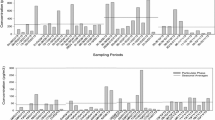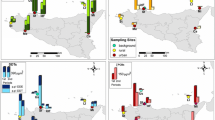Abstract
From simultaneous air and water polychlorinated biphenyl (PCB) measurements collected in September 2010, we re-evaluated the direction and magnitude of net air-water exchange of PCBs in southwest Lake Michigan and compared them with estimations made using similar approaches 15 years prior. Air and water samples were collected during a research expedition on Lake Michigan at 5 km off the coast of Chicago, with prevailing winds from the southwest of our location. Gas-phase ΣPCB concentrations ranged from 190 to 1100 pg m−3 with a median of 770 pg m−3, which is similar to the concentrations measured in the City of Chicago at the same time and similar to concentrations measured in this part of the lake over the last 20 years. Water dissolved-phase ΣPCB concentrations ranged from 150 to 170 pg L−1 with a median of 160 pg L−1, which is one-tenth of that measured in the 1990s. ƩPCB net fluxes showed a slightly absorptive behavior, with a median of (−) 21 ng m−2 day−1 and an interquartile range of (−) 47 to (+) 5 ng m−2 day−1, where (−) and (+) fluxes indicate absorption and volatilization, respectively. Airborne PCB concentrations were higher when the winds were coming from Chicago and drive the deposition. Our fluxes are not significantly different from estimations from 1994 and 1995 and suggest that absorption of PCBs into the waters is slightly more prevalent than 15 years ago. It was confirmed that Chicago remains an important atmospheric source of PCBs to Lake Michigan.




Similar content being viewed by others
References
Ampleman MD, Martinez A, DeWall J, Rawn DFK, Hornbuckle KC, Thorne PS (2015) Inhalation and dietary exposure to PCBs in urban and rural cohorts via congener-specific measurements. Environ Sci Technol 49:1156–1164. https://doi.org/10.1021/es5048039
Anderson DJ, Bloem TB, Blankenbaker RK, Stanko TA (1999) Concentrations of polychlorinated biphenyls in the water column of the Laurentian Great Lakes: spring 1993. J Great Lakes Res 25:160–170. https://doi.org/10.1016/S0380-1330(99)70724-0
Anezaki K, Nakano T (2014) Concentration levels and congener profiles of polychlorinated biphenyls, pentachlorobenzene, and hexachlorobenzene in commercial pigments. Environ Sci Pollut Res 21:998–1009. https://doi.org/10.1007/s11356-013-1977-2
Awad AM, Martinez A, Marek RF, Hornbuckle KC (2016) Occurrence and distribution of two hydroxylated polychlorinated biphenyl congeners in Chicago air. Environ Sci Technol Let 3:47–51. https://doi.org/10.1021/acs.estlett.5b00337
Bicksler J (1996) PCBs in spring-time water column of the Great Lakes. MS thesis. University of Minnesota, Minneapolis
Boesen AC, Martinez A, Hornbuckle KC (2019) PCB congener data of gas-phase, dissolved water, meteorological conditions, and air-water PCB fluxes in southwestern Lake Michigan, 2010. PANGAEA. https://doi.org/10.1594/PANGAEA.897545
Burkhard LP (2000) Estimating dissolved organic carbon partition coefficients for nonionic organic chemicals. Environ Sci Technol 34:4663–4668. https://doi.org/10.1021/es001269l
DeCaprio AP, Johnson GW, Tarbell AM, Carpenter DO, Chiarenzelli JR, Morse GS, Santiago-Rivera AL, Schymura MJ (2005) Polychlorinated biphenyl (PCB) exposure assessment by multivariate statistical analysis of serum congener profiles in an adult Native American population. Environ Res 98:284–302. https://doi.org/10.1016/j.envres.2004.09.004
Doskey PV, Andren AW (1981) Concentrations of airborne PCBs over Lake Michigan. J Great Lakes Res 7:15–20. https://doi.org/10.1016/S0380-1330(81)72018-5
Green ML, Depinto JV, Sweet C, Hornbuckle KC (2000) Regional spatial and temporal interpolation of atmospheric PCBs: interpretation of Lake Michigan mass balance data. Environ Sci Technol 34:1833–1841. https://doi.org/10.1021/es990374w
Hornbuckle KC, Sweet CW, Pearson RF, Swackhamer DL, Eisenreich SJ (1995) Assessing annual water-air fluxes of polychloirnated-biphenyls in Lake Michigan. Environ Sci Technol 29:869–877. https://doi.org/10.1021/es00004a006
Hornbuckle KC, Carlson DL, Swackhamer DL, Baker JE, Eisenreich SJ (2006) Polychlorinated Biphenyls in the Great Lakes. In: Hites RA (ed) Persistent organic pollutants in the Great Lakes. Springer Berlin Heidelberg, Berlin, Heidelberg, pp 13–70
Hu DF, Hornbuckle KC (2010) Inadvertent polychlorinated biphenyls in commercial paint pigments. Environ Sci Technol 44:2822–2827. https://doi.org/10.1021/es902413k
Hu DF, Martinez A, Hornbuckle KC (2008) Discovery of non-Aroclor PCB (3,3′-Dichlorobiphenyl) in Chicago air. Environ Sci Technol 42:7873–7877. https://doi.org/10.1021/es801823r
Hu DF, Lehmler HJ, Martinez A, Wang K, Hornbuckle KC (2010) Atmospheric PCB congeners across Chicago. Atmos Environ 44:1550–1557. https://doi.org/10.1016/j.atmosenv.2010.01.006
Indiana University (2017) Integrated atomospheric deposition network (IADN) data visualization tool, IADN data Viz. Indiana University, Bloomington
Jahnke JC, Hornbuckle KC (2019) PCB Emissions from Paint Colorants. Environ Sci Technol. https://doi.org/10.1021/acs.est.9b01087
Koh WX, Hornbuckle KC, Thorne PS (2015) Human serum from urban and rural adolescents and their mothers shows exposure to polychlorinated biphenyls not found in commercial mixtures. Environ Sci Technol 49:8105–8112. https://doi.org/10.1021/acs.est.5b01854
Lefkovitz LF (1987) The particle mediated fractionation of PCBs in Lake Michigan. MS thesis. University of Wisconsin, Madison
Li A, Rockne KJ, Sturchio N, Song WL, Ford JC, Wei H (2009) PCBs in sediments of the Great Lakes - distribution and trends, homolog and chlorine patterns, and in situ degradation. Environ Pollut 157:141–147. https://doi.org/10.1016/j.envpol.2008.07.014
Livingstone DM, Imboden DM (1993) The nonlinear influence of wind-speed variability on gas transfer in lakes. Tellus B 45:275–295. https://doi.org/10.1034/j.1600-0889.1993.t01-2-00005.x
Magar VS, Brenner RC, Johnson GW, Quensen JF (2005) Long-term recovery of PCB-contaminated sediments at the Lake Hartwell superfund site: PCB Dechlorination. 2. Rates and extent. Environ Sci Technol 39:3548–3554. https://doi.org/10.1021/es0486216
Martinez A, Hornbuckle KC (2011) Record of PCB congeners, sorbents and potential toxicity in core samples in Indiana Harbor and Ship Canal. Chemosphere 85:542–547. https://doi.org/10.1016/j.chemosphere.2011.08.018
Martinez A, Wang K, Hornbuckle KC (2010) Fate of PCB congeners in an Industrial Harbor of Lake Michigan. Environ Sci Technol 44:2803–2808. https://doi.org/10.1021/es902911a
Martinez A, Hadnott BN, Awad AM, Herkert NJ, Tomsho K, Basra K, Scammell MK, Heiger-Bernays W, Hornbuckle KC (2017) Release of airborne polychlorinated biphenyls from New Bedford Harbor results in elevated concentrations in the surrounding air. Environ Sci Technol Let 4:127–131. https://doi.org/10.1021/acs.estlett.7b00047
Martinez A, Awad AM, Herkert NJ, Hornbuckle KC (2019) Determination of PCB fluxes from Indiana Harbor and Ship Canal using dual-deployed air and water passive samplers. Environ Pollut 244:469–476. https://doi.org/10.1016/j.envpol.2018.10.048
Miller SM, Hornbuckle KC (2010) Spatial and temporal variations of persistent organic pollutants impacted by episodic sediment resuspension in southern Lake Michigan. J Great Lakes Res 36:256–266. https://doi.org/10.1016/j.jglr.2010.02.009
Miller SM, Green ML, Depinto JV, Hornbuckle KC (2001) Results from the Lake Michigan mass balance study: concentrations and fluxes of atmospheric polychlorinated biphenyls and trans-nonachlor. Environ Sci Technol 35:278–285. https://doi.org/10.1021/es991463b
Nwobi FN, Ugomma CA (2014) Comparison of methods for the estimation of Weibull distribution parameters. Metodol zv 1:65–78
Offenberg JH, Baker JE (2000) PCBs and PAHs in southern Lake Michigan in 1994 and 1995: urban atmospheric influences and long-term declines. J Great Lakes Res 26:196–208. https://doi.org/10.1016/S0380-1330(00)70686-1
Rastogi SC (1992) Investigaction of isomer specific polychlorinated-biphenyls in printing inks. Bull Environ Contam Toxicol 48:567–571
Rodenburg LA, Meng QY (2013) Source apportionment of polychlorinated biphenyls in Chicago air from 1996 to 2007. Environ Sci Technol 47:3774–3780. https://doi.org/10.1021/es305024p
Salamova A, Venier M, Hites RA (2015) Revised temporal trends of persistent organic pollutant concentrations in air around the Great Lakes. Environ Sci Technol Let 2:20–25. https://doi.org/10.1021/acs.estlett.5b00003
Schwarzenbach RP, Gschwend PM, Imboden DM (2003) Environmental organic chemistry, 2nd edn. Wiley, New York
Simcik MF, Zhang HX, Eisenreich SJ, Franz TP (1997) Urban contamination of the Chicago coastal Lake Michigan atmosphere by PCBs and PAHs during AEOLOS. Environ Sci Technol 31:2141–2147. https://doi.org/10.1021/es9609765
Streets SS, Henderson SA, Stoner AD, Carlson DL, Simcik MF, Swackhamer DL (2006) Partitioning and bioaccumulation of PBDEs and PCBs in Lake Michigan. Environ Sci Technol 40:7263–7269. https://doi.org/10.1021/es061337p
Swackhamer DL, Armstrong DE (1987) Distribution and characterization of PCBs in Lake Michigan water. J Great Lakes Res 13:24–36. https://doi.org/10.1016/S0380-1330(87)71624-4
USEPA, 2004. Results of the Lake Michigan mass balance project; polychlorinated biphenyls and trans-nonchlor data report. EPA 905 R-01-011
Venier M, Dove A, Romanak K, Backus S, Hites R (2014) Flame retardants and legacy chemicals in Great Lakes’ water. Environ Sci Technol 48:9563–9572. https://doi.org/10.1021/es501509r
Zhang H, Eisenreich SJ, Franz TR, Baker JE, Offenberg JH (1999) Evidence for increased gaseous PCB fluxes to Lake Michigan from Chicago. Environ Sci Technol 33:2129–2137. https://doi.org/10.1021/es981073+
Acknowledgments
We thank N. Herkert for assistance in laboratory work, Z. Rodenburg for the collection of the air and water samples including the extraction of the air samples, E. Jetter for managing the analytical laboratory, and the Captain and crew of the EPA R/V Lake Guardian. The content is solely the responsibility of the authors and does not necessarily represent the official views of the NIH or the U.S. Environmental Protection Agency.
Funding
Superfund Research Program of the National Institute of Environmental Health Sciences (Grant No. NIH P42ES013661) and the U.S. Environmental Protection Agency’s Great Lakes National Program Office (Grant No. GL-00E00515-0) provided funding,
Author information
Authors and Affiliations
Corresponding author
Ethics declarations
Conflict of interest.
The authors declare that they have no conflict of interest.
Additional information
Responsible editor: Gerhard Lammel
Publisher’s note
Springer Nature remains neutral with regard to jurisdictional claims in published maps and institutional affiliations.
Electronic supplementary material
ESM 1
(DOCX 2.48 mb).
Rights and permissions
About this article
Cite this article
Boesen, A.C., Martinez, A. & Hornbuckle, K.C. Air-water PCB fluxes from southwestern Lake Michigan revisited. Environ Sci Pollut Res 27, 8826–8834 (2020). https://doi.org/10.1007/s11356-019-05159-1
Received:
Accepted:
Published:
Issue Date:
DOI: https://doi.org/10.1007/s11356-019-05159-1




